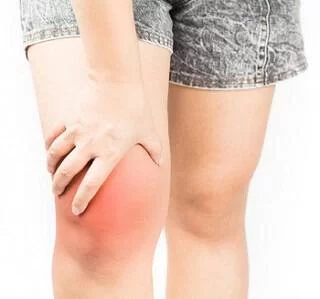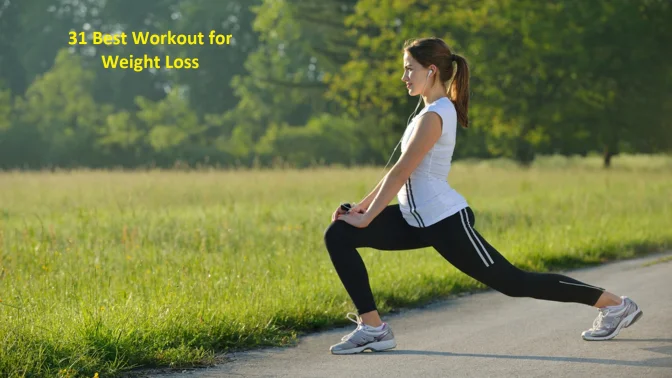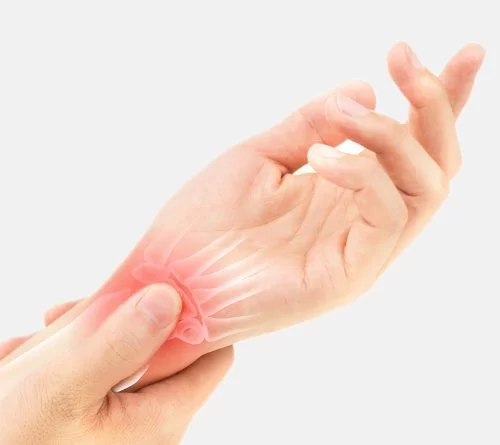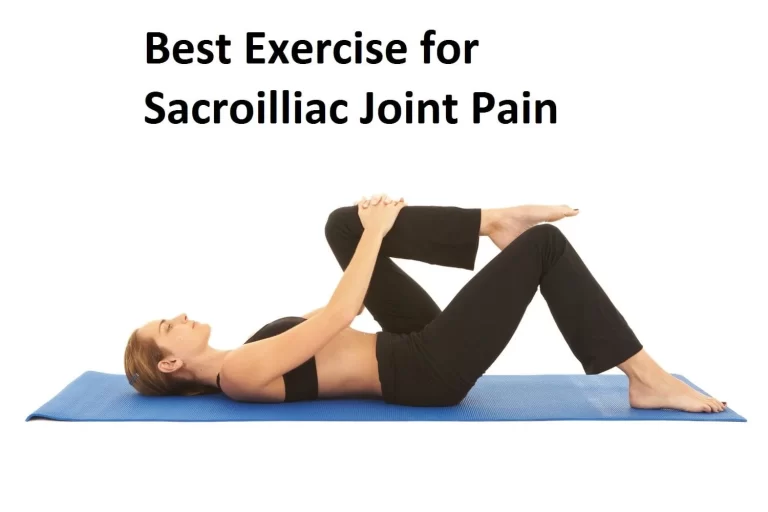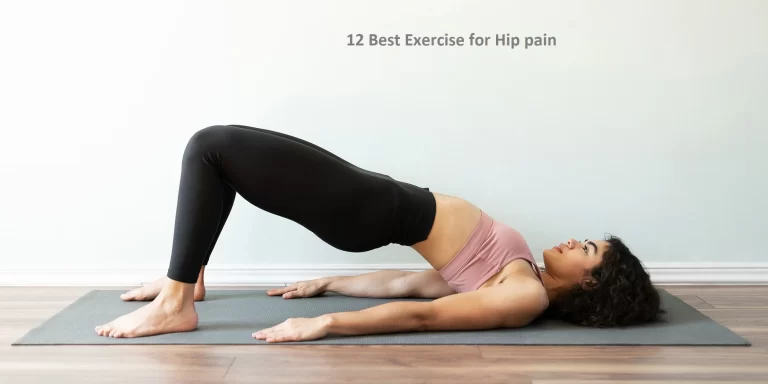15 Best Exercises For Patellar Fracture
Table of Contents
Introduction:
Best exercises for a patellar fracture focus on gently restoring knee mobility, improving quadriceps strength, and regaining normal function after healing. These exercises help reduce stiffness, improve stability, and support a safe return to daily activities under the guidance.
A painful and dangerous injury, a patellar fracture or break in the kneecap, usually requires extensive rest, medical attention, and a planned rehabilitation program. Regaining complete knee function, whether through surgery or non-surgical means, involves a slow, closely monitored exercise regimen to rebuild range of motion, strength, and flexibility.
Exercises for Patellar Fracture are crucial to the healing process. After a patella fracture, knee stiffness and pain are the most common aftereffects. As a result, exercise is essential to getting back to your regular life. Exercise enhances strength, muscle flexibility, joint stability, endurance, and balance. It also speeds up the healing process by increasing blood flow to the injured area.
To preserve knee mobility and muscular strength, you can immediately return to modest activity after your pain lessens. While relaxing is vital, taking too long to relax might delay your ability to heal fully.
A physiotherapist should be consulted before starting any fitness program to ensure that the exercises are suitable for your condition.
While performing these exercises, observe how your knee feels. If an exercise is causing you pain, stop. Don’t put weight or strain on your fractured knee; instead, begin with less challenging exercises.
Causes:
Injury to the Knee Directly
- Direct and powerful force on the kneecap.
- Dropping straight to a bent knee
Quick, Intense Quadriceps Contraction
- The patella may tear apart if the quadriceps muscle contracts forcefully when the knee is bent.
- Awkwardly landing or jumping
- Attempting to prevent a fall in the middle
- Walking on uneven ground or stairs
Auto Accidents
- High-energy trauma is frequently caused by the knee hitting the dashboard.
- Frequently causes comminuted fractures, in which the kneecap splits into several parts.
Falls
- Having a hard landing on one’s knees after sliding or falling from a height.
- Groups at Risk:
- Elderly people (particularly those with reduced bone density)
- Employees in dangerous jobs (like construction)
Bones that are unstable or weak (osteoporosis)
- If bone density is low, a fracture may result after a slight injury or accident.
- Senior citizens
- Individuals suffering from osteoporosis or osteopenia
Overuse or Repetitive Stress
- Long-term repetitive injuries from activities like sprinting, jumping, or kneeling.
- May result in patella stress fractures, particularly in athletes or military personnel.
Past Knee Injuries or Surgical Complications
- The bone may become weaker as a result of previous knee surgery, such as a total knee replacement.
- Raises the possibility of a patellar fracture even in cases of little trauma.
Unbalanced muscles
- Strong quadriceps and weak hamstrings might cause the quadriceps tendon to overstress the patella.
- If a quadriceps/hamstring muscle imbalance is not treated, a patella fracture may result.
Signs and symptoms:
Extreme Pain in the Anterior Knee
- Sudden, severe pain that is restricted to the front of the knee.
- Typically, right after trauma.
- Any attempt to rise, move, or extend the leg makes it worse.
Incapacity or Difficulty with Knee Extension
- Might not be able to raise the leg or straighten the knee when lying down.
Swelling in the Knee Area
- After an injury, swelling may appear quickly, between minutes and hours.
Having Trouble Walking
- Being unable to walk or having trouble bearing weight.
- Unable to bend one’s knee or limping.
Unstable Knees
- Having the sensation that the knee is weak or might “drop out.”
Tenderness
- Patellar soreness in certain areas, particularly when touched.
Observable Deformity
- The patella may seem deformed or out of place in displaced fractures.
- In cases where the fracture is serious, a gap may be felt over the kneecap.
Benefits of exercise:
Exercise can significantly hasten recovery and prevent more injuries if done correctly.
Enhances Confidence and Mental Health
- Depression, anxiety, or frustration can result from injury and inactivity.
- Structured therapy helps you stay focused during recovery, improves your mood, and gives you a sense of progress.
Knee Range of Motion Restored
- The knee may become tight and challenging to bend or straighten following a fracture and a period of immobility.
- Regaining flexibility through mild exercises like passive knee extensions and heel slides helps avoid chronic joint stiffness.
Strengthens the Muscles Around It
- Rapid muscle atrophy follows a knee injury, particularly in the quadriceps.
- Strength exercise, such as quad sets and straight leg lifts, improves joint stability and support by rebuilding the muscles surrounding the knee.
Enhances the Ability to Walk and Bear Weight
- Unbalance and weakness can make walking dangerous or challenging.
- Progressive weight-bearing exercises that train your body to walk in its best form will enhance your mobility and gait.
Restoring stability and coordination
- Your body’s proprioception, or sensation of position and movement, may be impacted by a fracture.
- Proprioceptive training and balance exercises assist in restoring movement confidence and lower the chance of falls.
Lessens Stiffness and Pain
- Over time, inactivity may result in increased pain and stiffness.
- Over time, controlled motion reduces stiffness, releases endorphins, and maintains the joint.
Ensures a Safer and Quicker Return to Regular Activities
- Knee strength and flexibility are necessary for activities like sitting, climbing stairs, and getting in and out of cars.
- You can return to your everyday activities and regain your independence more quickly with functional training.
Lowers the Chance of Reinjury
- Future falls or fractures are more likely to occur in a knee that is weak or unstable.
- Increasing muscle strength and balance lowers the chance of future injuries by protecting the joint.
The following safety measures should be taken into account before beginning an exercise program:
- Consider a few safety measures and maximize the benefits before starting any health program.
- The best workouts for your particular problem will depend on your doctor or physiotherapist.
- Avoid pushing yourself when your body is uncomfortable; instead, listen to what it needs.
- Although pain is a typical side effect of exercise, persistent or severe pain could indicate overwork.
- Begin with low-impact exercises and work your way up to more challenging ones until you can tolerate more pain.
- Maintaining good posture and form can help avoid repetitive injuries.
- Consult your physician for advice on how to start exercising properly.
- Before beginning a workout session, warm up your joints and muscles to prepare them.
Best Exercises For Patellar Fracture:
You can help reduce pain and enhance your general health by including these exercises in your routine, along with proper posture and movement awareness. Always get advice from a physiotherapist before beginning a new exercise program, especially if you have a particular injury or condition.
Ankle rotation
- First, settle into the chair comfortably.
- To relax comfortably on both feet, use a chair that supports you.
- For added stability and support throughout this exercise, keep your hands by your sides on the chair’s edge.
- Repeat ten times in one direction and ten times in the opposite direction around your ankle.
- Then return to your neutral position.
- Then relax.
- Repeat these exercises 5 to 10 times.
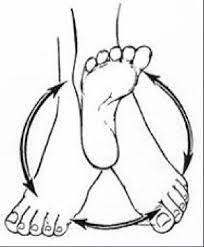
Ankle pump
- Sit or lie down with your back against a chair.
- Legs have been stretched out and slightly apart.
- For the soles to be flat, the toes must point upward.
- Your feet should be pointed as close to your knees as you can.
- Next, make every effort to direct them away from you.
- Step by step, bend your feet in each direction to finish the task.
- Hold your toes stretched for a few seconds during this short period of time.
- Next, return your foot gradually to the point where it is level with the floor.
- Then return to your neutral position.
- Then relax.
- Repeat these exercises 5 to 10 times.
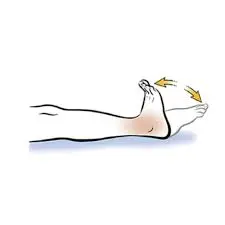
Heel slide
- To start, settle into a comfortable position on the floor.
- Your feet should be slightly apart.
- Proceed to the affected leg as near to your buttocks as you can.
- Gently move your leg close enough to touch your buttocks.
- Hold this position for a few seconds.
- Then return to your neutral position.
- Then relax.
- Repeat these exercises 5 to 10 times.
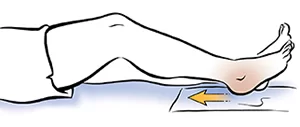
Quad Sets
- With your back supported, sit with your legs straight out in front of you.
- Place a tiny rolled towel beneath your knee.
- Pull one foot towards you while moving the other foot slightly to the side.
- Pressing your leg down firmly will cause your thigh muscles to tense.
- Hold this position for a few seconds.
- Then return to your neutral position.
- Then relax.
- Repeat these exercises 5 to 10 times.

Straight Leg Raises
- Start by lying on your back on the bed.
- Make sure your foot is flat on the floor by bending one knee.
- Maintain a calm and straight other leg.
- For support, keep your arms by your sides, palms down.
- To tighten your quadriceps, the muscles on top of your thigh, use the straight leg.
- Raise your other leg gradually to about the height of your bent knee while maintaining a straight one.
- Hold this position for a few seconds.
- Return your leg to the floor slowly and gently.
- Then return to your neutral position.
- Then relax.
- Repeat these exercises 5 to 10 times.

Clamshells
Clamshell steps:
- You lie on your side first.
- Bend your elbow while you are lying on your left side.
- The support should then be held up to your head with your left hand.
- Lean your right foot and leg over your left to create a 45-degree angle with your knees.
- Use your right hand to balance by placing it on your hip or lightly on the ground in front of you.
- Next, maintain your feet close to your body as you raise your right knee slightly towards the sky.
- Hold this position for a few seconds.
- Lower your leg.
- Then return to your neutral position.
- Then relax.
- Repeat these exercises 5 to 10 times.
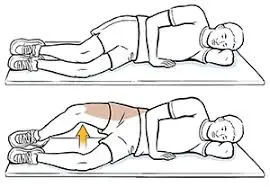
Knee extension
- When sitting in a stable chair, your feet should be flat on the floor.
- Keep your back straight and your core firm as you place your legs hip-width apart.
- Your knees should bend at a 90-degree angle.
- Slowly straighten one leg in front of you, taking care to keep the knee straight.
- Hold this position for a few seconds.
- Drop your leg.
- Then return to your neutral position.
- Then relax.
- Repeat these exercises 5 to 10 times.
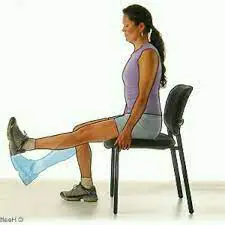
Standing Hamstring Curls
- Begin by standing in a comfortable position.
- You should space your feet hip-width apart.
- Lift one foot, extend your knee, and lift your heel towards the sky.
- Maintaining a straight upper body and forward-pointing legs, stretch as far as you can.
- Hold this position for a few seconds.
- Slowly lower your heels to the beginning position.
- Then return to your neutral position.
- Then relax.
- Repeat these exercises 5 to 10 times.

Hip abduction
- To begin, lie on one side on the floor. Maintain a neutral foot position and bend your lower arm behind your head for support.
- Bend your lower leg after that.
- Next, exhale and lift your upper leg off your lower leg with caution.
- The hips of the raised leg should remain parallel to the floor, and the knee should point straight away from you.
- Continue raising the leg until your hips start to lean forward or your lower back muscles start to tighten.
- Hold this position for a few seconds.
- After taking a deep breath, carefully move your leg back to the starting position.
- Then return to your neutral position.
- Then relax.
- Repeat these exercises 5 to 10 times.

Step up
- Get started by standing on the floor.
- A step box or lower platform should then be placed in front of you.
- Put the injured foot, for example, the right foot if the right leg is fractured, on the step.
- Push through your heel to straighten your hips and knees and elevate your body.
- Instead of using force, use muscular control.
- Raise the healthy foot to the step.
- Hold this position for a few seconds.
- Slowly lower again, beginning with the uninjured foot and working your way down to the affected one.
- Then return to your neutral position.
- Then relax.
- Repeat these exercises 5 to 10 times.
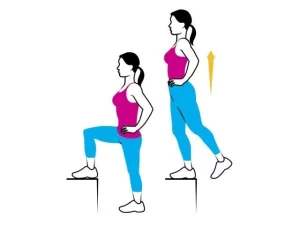
Standing heel raise
- Get a seat behind a chair.
- Next, rest your hands on the back of the chair for stability.
- You should space your feet hip-width apart.
- Placing your weight on your toes requires you to lift your heels off the ground.
- Hold this position for a few seconds.
- Then return to your neutral position.
- Then relax.
- Repeat these exercises 5 to 10 times.

Mini squat
- Start with a relaxing standing position on the floor.
- Maintain a balanced weight distribution on both feet and use your core muscles.
- Use a wall, a sturdy chair, or a countertop as support to maintain your balance.
- Squat by pushing your hips back and down and bending your knees slightly, much like you would when sitting in a chair.
- Generally speaking, the thighs should be between 30 and 45 degrees off the ground, or slightly inclined.
- Drop only as far as it is comfortable.
- Keep your chest up straight and your knees from extending past your toes.
- Hold this position for a few seconds.
- Then return to your neutral position.
- Then relax.
- Repeat these exercises 5 to 10 times.

Leg Press with Resistance Band
- Using a comfortable, elastic stretch band is the best approach to finish this exercise.
- Place the centre of the elastic band at the arch of your foot while holding the ends in each hand.
- Bend your elbows while lying on the floor.
- By tightening the thigh muscles in your affected leg, you may move your knee closer to your chest.
- Raise your leg slowly in front of you after bending your foot and putting pressure on the elastic band.
- Hold this position for a few seconds.
- Then return to your neutral position.
- Then relax.
- Repeat these exercises 5 to 10 times.

Hamstring stretch
- Start with a relaxing standing position on the floor.
- Position one leg’s ankle or heel on a surface that is waist-high or slightly below.
- To pull your thigh closer to the front of your trunk, bend at the hips.
- Hold this position for a few seconds.
- Then return to your neutral position.
- Then relax.
- Repeat these exercises 5 to 10 times.
- Utilize your other leg for this workout.

Single-leg balance
- You should stand with your feet hip-width apart.
- Keep your back straight and use your core.
- Equally distribute your weight across both feet.
- Gradually transfer your weight to one leg, such as your right leg.
- Bending the knee slightly, raise the left foot, which is the opposite foot, off the ground.
- Don’t lock your support leg; instead, keep it slightly bent.
- Face forward and maintain a level hip position.
- To improve your balance, keep your gaze focused on a spot in front of you.
- Depending on your capacity, attempt to maintain the balance for a few seconds.
- Continue to breathe regularly.
- Stay away from excessive arm waving or sideways leaning.
- Return to the starting position after carefully lowering the raised leg.
- Then return to your neutral position.
- Then relax.
- Repeat these exercises 5 to 10 times.

What safety measures need to be followed when working out?
Specific safety precautions and considerations for patellar fracture exercises are covered in the following:
Warm up and cool down
- Prepares joints and muscles, lowering the chance of harm.
- Use mild exercises like leg swings or ankle pumps to warm up.
- If necessary, cool down with ice therapy and gentle stretches.
Make Gradual Advancements
- Start with non-weight-bearing, low-impact activities.
- Gradually switch to functional and weight-bearing workouts.
Keep Your Workout Space Safe and Clean
- Stays away from accidents or falls that could cause a knee injury again.
- Make use of a stable floor surface or a non-slip mat.
- Wear non-slip, supportive shoes.
Keep an eye out for any swelling or soreness.
- Exercise should be discontinued if it causes severe or worsening pain.
- Even while slight soreness is normal, pain during or after an exercise may be a sign that you’re pushing yourself too hard.
- Use ice to reduce inflammation after working out.
Make progress gradually.
- Gradually increase the difficulty, resistance, and repetitions.
- Be sure to pay attention to your recovery plan properly.
Keep Your Posture Correct
- Keep your knees and feet in a neutral position during each exercise.
- To guarantee shape, use mirrors, wall support, or monitoring.
Pay Attention to Your Body
- Fatigue, edema, or pain could be signs of improper movement or excessive effort.
- Any exercise that results in joint locking or sharp pain should be stopped.
- If the knee becomes swollen or uncomfortable after an exercise, rest it and apply ice.
- Keep an eye out for symptoms of inflammation, such as redness, warmth, and swelling.
Stay Hydrated and Get Enough Sleep
- Encourages general healing and muscular repair.
- Hydrate well both before and after working out.
- Don’t overtrain and get enough sleep.
When did you quit working out?
Pain
- Deep, intense Knee pain during activity could indicate poor form, stiff joints, or strain.
- Pain could be a sign of re-injury, muscle strain, or inflammation.
Stable or Out of Balance
- The dislocation of the hip may affect balance.
- Patients may feel uncomfortable when performing exercises that require one leg or standing support.
A rise in oedema levels
- A certain amount of swelling is normal, but if it worsens, especially after multiple sessions, that may be a cause for concern.
- The causes could be improper development, abuse, or inflammation.
The wrong format or method
- Patients may perform tasks improperly if they are not closely monitored.
- Other joints may experience strain and compensatory movement as a result of poor posture.
Incapable of Bearing the Weight
- This could indicate severe inflammation or that the fracture has gotten worse.
- Pain gets worse over time rather than getting better.
Your chronic pain has left you exhausted or demotivated.
- Fatigue caused by pain may make it harder to stick to your treatment plan and raise your chance of making mistakes.
Fatigue and muscular weakness
- In the early stages of recovery, the hip and core muscles weaken.
- Muscle fatigue develops rapidly, especially during resistance or weight exercise.
If you have a patellar fracture, which exercises should you avoid?
Activities with a High Impact
These subjects are the healing of the kneecap to repeated or direct stress.
- Jogging or running
- Jumping (such as burpees, jump rope, and box jumps)
- Plyometric exercise
- Jumping or hopping exercises
Heavy Lower Body Weight Lifting
- Particularly, exercises that provide resistance to the knee joint.
- Barbell squats
- Leg presses with a lot of weight
- Lunges with weights
- Poorly done deadlifts can overload the quadriceps-patellar tendon system and put stress on the fracture site if the strain is transferred to the knees.
Heavy-Load Knee Extension Machine
- Particularly in the early stages of rehabilitation, stay away from utilizing the sitting leg extension machine with resistance.
- It puts the patella tendon and the fracture site under direct tension.
Exercises to Bend Your Knees Deeply
Particularly in the early stages of healing, these put excessive strain on the patella.
- Deep squats (beyond 90° flexion)
- Lunges that bend the knees deeply
- Leg presses at full range
- Sitting on your heels or kneeling (like in yoga’s child’s pose)
Unsupported Exercises with Just One Leg
- Squats on one leg
- Step-downs without assistance
- Balance board or early-phase BOSU ball squats
- The recovering leg might not be prepared for them since they require strong quad control and joint stability.
When to Consult a Physician
Stop working out and consult a doctor if you encounter:
- A sudden, intense knee pain
- Swelling without improvement
- Unable to support weight
- Feelings of clicking, catching, or locking
Summary:
Compared to other bones, the patella is comparatively more at risk. Males aged 20 to 50 years are more likely to have them. The primary cause of a patella fracture is a direct fall onto your knees or an impact with anything. A significant injury that can make it difficult to walk or straighten your knee is a patellar fracture.
A direct impact on the knee is typically the cause of a patella fracture. It may split into two parts or numerous tiny fragments, depending on how much force is put into it.
The process of recovering from a patellar fracture requires dedication, skilled advice, and focus. Although the following activities are necessary for a complete return to activity, the timetable for each patient may vary depending on their age, the extent of their injury, and the type of treatment they receive.
To help protect your knee and avoid more issues, your doctor might advise some lifestyle adjustments. This can include staying away from exercises that require frequent deep knee bending or squatting. Additionally, you should stay away from walking on steep inclines and climbing steps or ladders.
FAQ:
A patellar fracture: what is it?
A break in the kneecap, the little bone at the front of the knee that covers the joint and helps in leg extension, is known as a patellar fracture. It frequently happens as a result of sudden, powerful contractions of the quadriceps or direct trauma.
What signs of a patellar fracture are usual?
Severe knee pain in the front
Bruising and swelling
The leg cannot be straightened
Having trouble standing or walking
Tenderness
A patellar fracture: what causes it?
Landing directly on the knee.
A strong, rapid contraction of the muscles in the thighs.
Direct effects of accidents (such as injuries to the dashboard in an automobile accident)
How much time does it take to heal from a fractured patella?
Recovery time without surgery: 2-4 months for complete function, 2-3 months for basic mobility
Recovery from surgery: three to six months or longer, depending on complexity
Complete return to high-impact sports or activities: 4–9 months
If I have a patellar fracture, can I still walk?
The majority of patients are first instructed not to place any weight on the injured limb. Weight-bearing with a brace or crutches may be permitted gradually once healing starts and pain decreases, but only if your doctor recommends it.
Which exercises are recommended following a patellar fracture?
The first focus of the exercises is the maintained range of motion.
Later, functional training, balance, and gradual strengthening.
Are patellar fractures preventable?
Wearing protective gear when participating in high-risk activities is one way to lower your risk.
Building up your hamstrings and quadriceps muscles.
Fall prevention techniques, particularly for senior citizens.
Being cautious when walking on rough or slippery floors.
After a patellar fracture, is it okay to bend my knee?
No, not immediately. To protect the fracture, you will probably need to wear a brace that restricts knee bending in the early stages. Your doctor will progressively expand your range of motion, usually within 4–6 weeks of the bone beginning to recover.
What kinds of exercises are best avoided following a patellar fracture?
Lunges and deep squats
Leaping or running
Excessive leg extensions
Any physical activity that causes pain or edema
How frequently should I perform my rehabilitation exercises?
Two to three times a day throughout the early stages, particularly for mild movements and muscular activation.
3-5 times a week in later stages, with a focus on function, strength, and balance.
Always follow the frequency that your physiotherapist recommended.
Is it okay to use weights or resistance bands?
Yes, but only under a doctor’s supervision and in the later stages of treatment.
Bodyweight exercises are a good place to start, then add:
Resistance band
Light weights for the ankles
Mini-squats and step-ups
How can a person with a fractured patella sleep?
Your damaged leg should be elevated on cushions to keep it straight and minimise swelling when you sleep on your back if you have a broken patella. As an alternative, you might sleep on your side with pillows supporting the affected leg so that it stays on top. To avoid strain, do not sleep on your stomach.
References:
- C. M. Knee (2027, Feb. 28). This is a list of the top eight exercises for treating a fractured patella. Help me heal my knee. https://curemyknee.com/blogs/paella-fracture-best-exercises/
- Drez, D., and J. DeLee, Jr. (1994). [Book] Patellar fracture (p. 1240). PATELLA-FRACTURE.pdf https://brattonmd.com/wp-content/uploads
- Administration, March 18, 2023a. When I have a patella fracture, what workouts should I do? – Ligaments and Joints Surgery. Ligaments and Joints Surgery. https://ligamentsandjoints.com/what-exercises-should-i-do-after-fractured-patella/
- Patella fracture. September 26, 2025. The Cleveland Clinic. There is a patella fracture at https://my.clevelandclinic.org/health/diseases/22081
- Null. (undated).Voidd – CB Physical Therapy. The top five workouts for patellar fractures, as published by Cb Physiotherapy, https://cbphysiotherapy.in/exercise
- AAOS, OrthoInfo, “Patellar fractures” (broken kneecap) (n.d.). Orthoinfo.aaos.org/en/diseases–conditions/patellar-kneecap-fractures and
- Image 12, Website, N. March 5, 2024. Exercises for Strength. NHS.uk. Strength exercises: https://www.nhs.uk/live-well/exercise
- Image 13, Fitbymik. September 4, 2022. 20 minutes WORKOUT FOR STANDING ARMS AND ABS | Using Dumbbells | Avoiding Planks and Crunches | Avoiding Repeats [Video]. YouTube. ZaWRhONt-74: https://www.youtube.com/watch?v=


